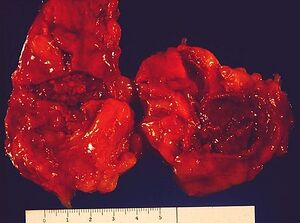Waterhouse-Friderichsen Syndrome
Waterhouse-Friderichsen syndrome (WFS) is a severe condition characterized by shock, disseminated intravascular coagulation, skin lesions, bilateral adrenal hemorrhages, and the presence of sepsis.[1].
History[edit | edit source]
The WFS was first described in 1911 by the British physician Rupert A. Waterhouse as a case of suprarenal apoplexy.
Carl Friderichsen was a Danish pediatrician who increased our understanding of WFS in 1918[1].
Etiology[edit | edit source]
WFS is associated with infection, most commonly in fulminant meningococcemia in Neisseria meningitidis infection. N. meningitis is far from the only one that can cause this syndrome. Etiologically, viruses (CMV, EBV, HIV, and parvovirus B19), bacteria (Staphylococcus aureus, Haemophilus influenzae, Streptococcus pneumoniae, Pseudomonas aeruginosa, Escherichia coli, and Mycobacterium tuberculosis), fungi (Histoplasum, such as trauma, pregnancy, DIC, surgery, and anticoagulant therapy[1].
Clinical Picture[edit | edit source]
Clinically, hip, epigastric or abdominal pain appears first. Other symptoms may include chills, myalgia, headache, vertigo, nausea, vomiting. A few hours later, hypotension and petechial lesions on the skin and mucous membranes ("flowers of death") appear. Major subcutaneous hemorrhage is referred to as purpura fulminans and is the result of DIC. Petechiae first appear on the wrists and ankles and then spread throughout the body, omitting the head, palms, and soles of the feet. Diagnosing WFS can be very difficult, despite the abundant symptoms[1].
Adrenal hemorrhage is relatively rare. For adrenal failure, approximately 90% of both adrenal glands must be destroyed, so only about 10% of adrenal hemorrhage cases develop adrenal failure. The pathophysiology of the development of bleeding is not entirely clear, however, it is explained as follows. The adrenal glands have a rich arterial supply as opposed to the venous. In a stressful situation, ACTH is released, increasing adrenal perfusion. At the same time, the action of catecholamines spasms the draining veins. Blood outflow can be complicated by thrombosis in coagulopathies. In the adrenal vessels, there is a significant increase in pressure leading to hemorrhages[1].
Therapy[edit | edit source]
Due to its severity, WFS therapy should begin as soon as possible. If the cause is unknown, broad-spectrum antibiotics are chosen, in adults 3rd-generation cephalosporins (cefotaxime, ceftriaxone)[1].
Supportive therapy includes maintaining a sufficient level of fluids (or minerals), respiratory support, inotropics, replacement of adrenal hormones, etc.[1].
Despite aggressive therapy, many patients die within 24-36 hours (due to multiorgan failure)[1].

